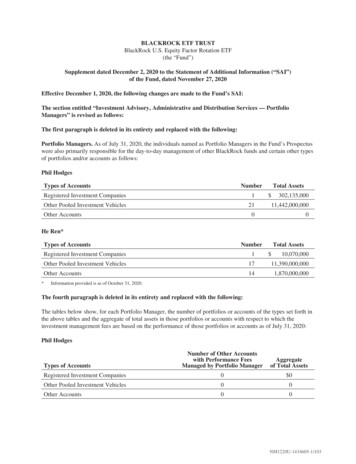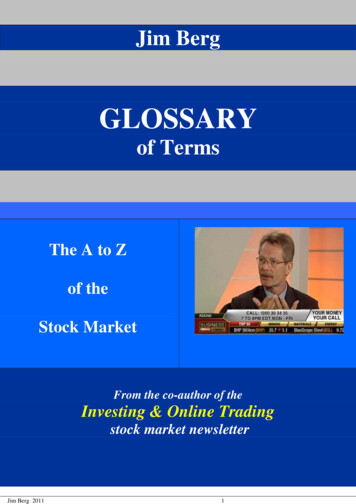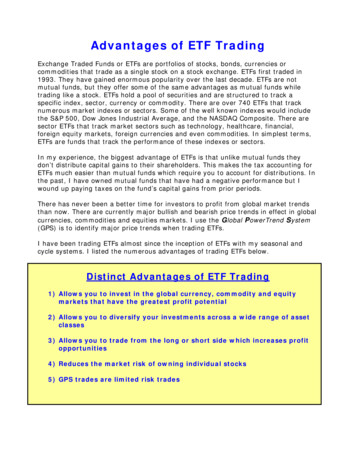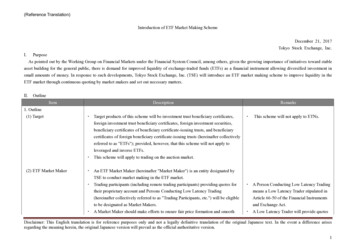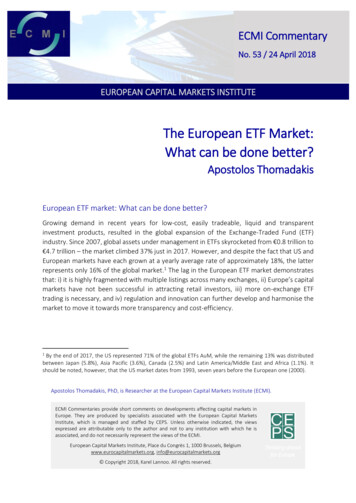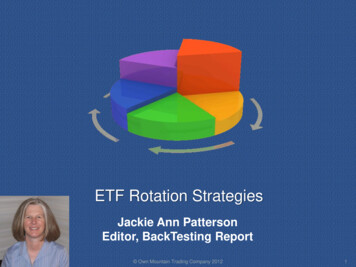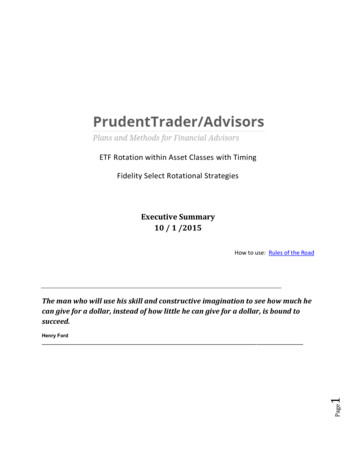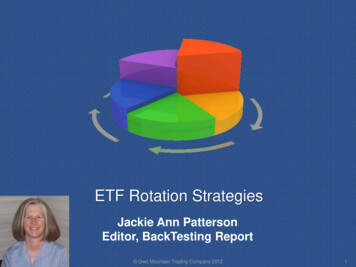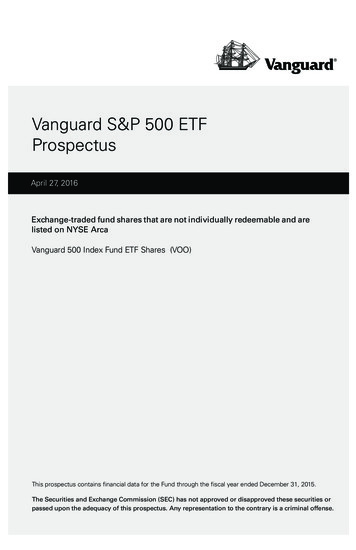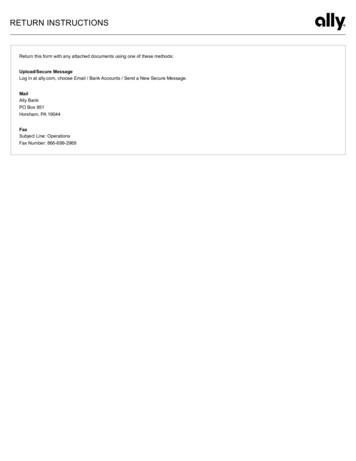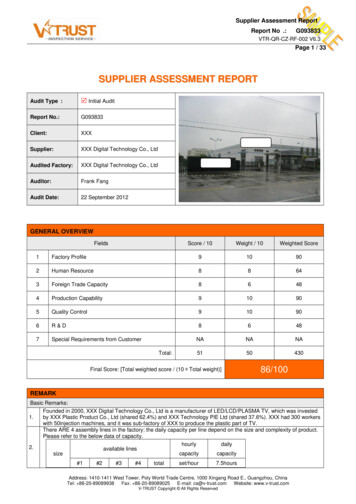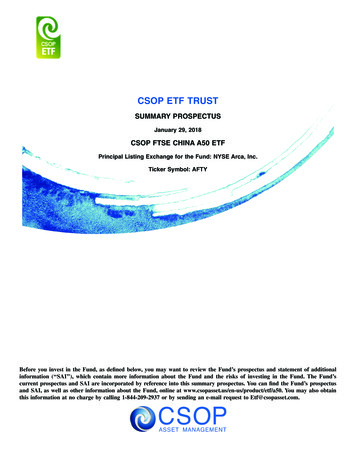
Transcription
CSOP ETF TRUSTSUMMARY PROSPECTUSJanuary 29, 2018CSOP FTSE CHINA A50 ETFPrincipal Listing Exchange for the Fund: NYSE Arca, Inc.Ticker Symbol: AFTYBefore you invest in the Fund, as defined below, you may want to review the Fund’s prospectus and statement of additionalinformation (‘‘SAI’’), which contain more information about the Fund and the risks of investing in the Fund. The Fund’scurrent prospectus and SAI are incorporated by reference into this summary prospectus. You can find the Fund’s prospectusand SAI, as well as other information about the Fund, online at www.csopasset.us/en-us/product/etf/a50. You may also obtainthis information at no charge by calling 1-844-209-2937 or by sending an e-mail request to Etf@csopasset.com.
CSOP FTSE CHINA A50 ETFInvestment ObjectiveThe CSOP FTSE China A50 ETF (the ‘‘Fund’’) seeks to provide investment results that, before fees andexpenses, track the performance of the FTSE China A50 Net Total Return Index.Fund Fees and ExpensesThis table describes the fees and expenses that you may pay if you buy and hold shares of the Fund. Mostinvestors also will incur customary brokerage commissions when buying or selling shares of the Fund, whichare not reflected in the table or the Example. If the commissions were included in the Example, your costswould be higher.Annual Fund Operating Expenses(expenses that you pay each year as a percentage of the value of your investment)Management Fees . . . . . . . . . . . . . . . . . . . . . . . . . . . .Other Expenses . . . . . . . . . . . . . . . . . . . . . . . . . . . . . .Acquired Fund Fees and Expenses . . . . . . . . . . . . . . . . .Total Annual Fund Operating Expenses . . . . . . . . . . . . . .Fee Waiver(1) . . . . . . . . . . . . . . . . . . . . . . . . . . . . . . .Total Annual Fund Operating Expenses After Fee Waiver(1).0.70%0.00%0.00%0.00%0.00%0.70%(1) The Total Annual Fund Operating Expenses (before and after any fee waiver) in this fee table may notcorrelate to the expense ratios in the Fund’s financial highlights and financial statements because thefinancial highlights and financial statements reflect only the operating expenses of the Fund and do notinclude Acquired Fund Fees and Expenses, which are fees and expenses incurred indirectly by the Fundthrough its investments in certain underlying investment. CSOP Asset Management Limited, the Fund’sinvestment adviser (the ‘‘Adviser’’) has agreed to reduce its management fees in an amount equal to anyAcquired Fund Fees and Expenses incurred by the Fund from its investments in the CSOP FTSE ChinaA50 ETF, an affiliated fund advised by CSOP Asset Management Limited and traded on the Hong KongStock Exchange with similar investment strategies as the Fund. This undertaking will continue for at leasttwelve months from the date of this Prospectus.ExampleThis Example is intended to help you compare the cost of investing in the Fund with the cost of investing inother funds.The Example assumes that you invest 10,000 in the Fund for the time periods indicated and then redeem allof your shares at the end of those periods. The Example also assumes that your investment has a 5% returneach year and that the Fund’s operating expenses remain the same. Although your actual costs may be higheror lower, based on these assumptions your costs would be:1 Year3 Years5 Years10 Years 72 224 390 871Portfolio TurnoverThe Fund pays transaction costs, such as commissions, when it buys and sells securities (or ‘‘turns over’’ itsportfolio). A higher portfolio turnover rate may indicate higher transaction costs and may result in higher taxeswhen the Fund shares are held in a taxable account. These costs, which are not reflected in total annual fundoperating expenses or in the Example, affect the Fund’s performance. During the most recent fiscal year, theFund’s portfolio turnover rate was 34% of the average value of its portfolio.2
Principal Investment StrategiesThe Fund seeks long-term capital appreciation by tracking the performance of the FTSE China A50 Net TotalReturn Index (the ‘‘Index’’). The Index is comprised of A-Shares issued by the 50 largest companies in theChina A-Shares market. The Index is a net total return index. This means that the performance of the Indexassumes that dividends paid by the Index constituents, net of any withholding taxes, are reinvested inadditional shares of such Index constituents.A-Shares are a specific classification of equity securities issued by companies incorporated in the People’sRepublic of China (‘‘China’’ or the ‘‘PRC’’). A-Shares are denominated and traded in renminbi (‘‘RMB’’), theofficial currency of the PRC, on the Shenzhen and Shanghai Stock Exchanges. Under current Chineseregulations and subject to certain exceptions, foreign investors such as the Fund are permitted to invest inA-Shares only (i) through designated foreign institutional investors that meet certain requirements of and havebeen granted status by the China Securities Regulatory Commission (‘‘CSRC’’), or (ii) through theShanghai-Hong Kong Stock Connect program and other similar programs.Under the first approach, foreign investors such as the Fund are permitted to invest through institutionalinvestors designated as either a Qualified Foreign Institutional Investor (‘‘QFII’’) or a Renminbi QualifiedForeign Institutional Investor (‘‘RQFII’’). Under current regulations, each QFII and RQFII is permitted toinvest up to a specific aggregate dollar amount in A-Shares by China’s State Administration of ForeignExchange (‘‘SAFE’’). A QFII or RQFII may not invest in A-Shares above its quota amount, although to theextent that a QFII or RQFII has utilized its allocated investment quota, it may apply for an increase to itsquota. There, however, is no guarantee that such application will be granted.Under the second approach, since November of 2014, foreign investors have been permitted to invest ineligible China A-Shares listed on the Shanghai Stock Exchange through the Shanghai-Hong Kong StockConnect program. The Shanghai-Hong Kong Stock Connect program, which was launched in 2014,established a securities trading and clearing program that enables mutual stock market access betweenmainland China and Hong Kong. Through the Shanghai-Hong Kong Stock Connect program, foreign investorssuch as the Fund can trade eligible China A-Shares subject to trading limits and rules and regulations as maybe issued from time to time. More recently, in December of 2016 foreign investors are also permitted to investin eligible China A-Shares listed on the Shenzhen Stock Exchange through the Shenzhen-Hong Kong StockConnect program. While the Fund may access China A-Shares through the Shenzhen-Hong Kong StockConnect program in the future, it has no immediate plans to do so.The Adviser is a licensed RQFII and QFII. The Adviser, on behalf of the Fund, may invest in A-Shares andother securities of Chinese companies listed for trading on the Shanghai and Shenzhen Stock Exchanges up toits designated quota amount. The Adviser, on behalf of the Fund, also will invest in eligible China A-Sharesvia the Shanghai-Hong Kong Stock Connect program.The Fund will typically invest at least 80% of its total assets in the securities included in the Index. The Fundmay invest the remainder of its assets in investments that are not included in the Index, but which the Adviserbelieves will help the Fund track the Index. These investments include: (i) interests in pooled investmentvehicles tracking the Index or similar indexes, including affiliated and non-U.S. funds (certain of these fundsmay not be registered under the Investment Company Act of 1940, as amended (the ‘‘1940 Act’’), andtherefore are not subject to the same investor protections as the Fund); (ii) other securities not included in theIndex (including H-Shares, which are shares of a company incorporated in mainland China that aredenominated in Hong Kong dollars and listed on the Hong Kong Stock Exchange or other foreign exchange);and (iii) certain derivatives, such as futures contracts and options contracts on equity securities designed toprovide similar exposure to the Index. Subject to the requirement to generally invest at least 80% of its totalassets in the securities of the Index, the Fund also may invest in money market instruments, cash and cashequivalents.In seeking to track the performance of the Index, the Fund uses a representative sampling indexing strategy.‘‘Representative sampling’’ is an indexing strategy that involves investing in a representative sample ofsecurities that collectively has an investment profile similar to the Index. The securities selected are expectedto have, in the aggregate, investment characteristics (based on factors such as market capitalization andindustry weightings), fundamental characteristics (such as return variability and yield) and liquidity measures3
similar to those of the Index. The Fund may or may not hold all of the securities in the Index. Unlike manyinvestment companies, the Fund does not try to ‘‘beat’’ the Index and does not seek temporary defensivepositions when markets decline or appear overvalued.The Fund is considered to be ‘‘diversified’’ and therefore must meet certain diversification requirements underthe 1940 Act. To the extent the Fund’s Index concentrates (i.e., holds 25% or more of its total assets) in thesecurities of a particular industry or group of industries, the Fund will concentrate its investments toapproximately the same extent as the Index. As of December 31, 2017, the Index was concentrated in thefinancial sector.The Index is sponsored by FTSE International Limited (the ‘‘Index Provider’’). The Index Provider determinesthe composition of the Index and relative weightings of the Index constituents, and publishes informationregarding the market value of the Index.Principal RisksAs with all investments, the value of an investment in the Fund can be expected to go up or down. You canlose money on your investment, including the possible loss of the entire principal amount of your investment,over short- or long-term periods. An investment in the Fund is not a deposit in a bank and is not insured orguaranteed by the Federal Deposit Insurance Corporation or any other government agency. The principal riskfactors affecting your investments in the Fund are described below. Each of these factors could cause thevalue of an investment in the Fund to decline.Risk of Investing in China — Investing in securities of companies organized and listed in China subjects theFund to risks specific to China. China is a developing market, and as a result, investments in securities ofcompanies organized and listed in China may be subject to liquidity constraints and significantly highervolatility, from time to time, than investments in securities of more developed markets. China may be subjectto considerable government intervention and varying degrees of economic, political and social instability.Internal social unrest or confrontations with other neighboring countries, including military conflicts inresponse to such events, could have a significant impact on the economy of China (and the world). Reductionin spending on Chinese products and services, institution of tariffs or other trade barriers, or a downturn inany of the economies of China’s key trading partners may have an adverse impact on the Chinese economy.There is no guarantee that the Chinese government will not revert from its current open-market economy tothe economic policy of central planning that it implemented prior to 1978. These factors may result in, amongother things, a greater risk of stock market, interest rate, and currency fluctuations, as well as inflation.Accounting, auditing and financial reporting standards in China are different from U.S. standards and,therefore, disclosure of certain material information may not be made. In addition, less information may beavailable to the Fund and other investors than would be the case if the Fund’s investments were limited tosecurities of U.S. issuers. It may also be difficult or impossible for the Fund to obtain or enforce a judgmentin a Chinese court.Risk of Investments in A-Shares — The Index is comprised of A-Shares listed on the Shanghai and ShenzhenStock Exchanges. In seeking to track the performance of the Index, the Fund intends to invest directly inA-Shares through the Adviser’s RQFII quota, and will also invest in eligible A-Shares through theShanghai-Hong Kong Stock Connect program. Therefore, the size of the Fund’s direct investment in A-Sharesis limited by both the size of the Adviser’s RQFII quota and any trading limits or other restrictions applicableto A-Shares traded through the Shanghai-Hong Kong Stock Connect program. This places practical limitationson the size of the Fund and may have a negative impact on trading of Fund shares. In addition, the RQFIIquota of the Adviser may be reduced or revoked by the Chinese regulators if, among other things, the Adviserfails to comply with applicable Chinese regulations. If the Adviser’s RQFII quota was, or RQFII quotasgenerally were, reduced or eliminated, the Fund could be required to dispose of a portion of its A-Sharesholdings. This would likely have a material adverse impact on the Fund’s performance and its ability to meetits investment objective. If the Fund is unable to obtain sufficient exposure to the performance of the Indexdue to the limited availability of the Adviser’s RQFII quota, or trading or other restrictions on theShanghai-Hong Kong Stock Connect program, the Fund could be forced to limit or suspend the issuance ofnew shares until the Adviser determines that the requisite exposure to the Index is obtainable. Any limits on4
the Fund’s ability to issue new shares could cause the Fund’s shares to trade at a premium or discount to thenet asset value (‘‘NAV’’) of the Fund and the Fund could experience substantial redemptions.The Chinese government may intervene in the A-Shares market and halt or suspend trading of A-Sharesecurities for short or even extended periods of time. Recently, the A-Shares market has experiencedconsiderable volatility and been subject to frequent and extensive trading halts and suspensions. These tradinghalts and suspensions have, among other things, contributed to uncertainty in the markets and reduced theliquidity of the securities subject to such trading halts and suspensions, including a number of securities heldby the Fund. If the trading in a significant number of the Fund’s A-Share holdings is halted or suspended, theFund’s portfolio could become illiquid. In such event, the Fund may have difficulty selling its portfoliopositions until the trading halt or suspension is lifted, or may not be able to sell such securities at all. As aresult, the Fund may need to sell other more liquid portfolio holdings at a loss or at times when it otherwisewould not do so to generate sufficient cash to satisfy redemption requests. This could have a negative impacton the Fund’s performance and increase the Fund’s tracking error. If a significant number of securities held bythe Fund are suspended or unavailable for sale, the Fund is permitted to delay settlement of redemptionrequests up to seven days, as further discussed in the Fund’s Statement of Additional Information (‘‘SAI’’).Trading halts or suspensions may make it difficult for the Fund to obtain prices for such securities and mayrequire the Fund to ‘‘fair value’’ a portion of its portfolio holdings (as described below in ‘‘Pricing ofFund Shares’’). In such case, the determined fair value for an investment may be different than the valuerealized upon the disposition of such investment. Furthermore, trading halts or suspensions of the Fund’sportfolio securities may also have a negative impact on the trading price of Fund shares and increase thevolatility of such trading prices.Risk of Investment and Repatriation Restrictions — Investments by the Fund in PRC securities are subject togovernmental pre-approval limitations on the quantity that the Fund may purchase, as well as limits on theclasses of securities in which the Fund may invest. Repatriations by RQFIIs are currently permitted daily andare not subject to repatriation restrictions or prior regulatory approval. However, there is no assurance thatPRC rules and regulations will not change or that repatriation restrictions will not be imposed in the future.Further, such changes to the PRC rules and regulations may be applied retroactively. Any restrictions onrepatriation of the Fund’s portfolio investments may have an adverse effect on the Fund’s performance and theFund’s ability to meet redemption requests.A-Shares Tax Risk — The Fund’s investments in A-Shares will be subject to a number of taxes and taxregulations in China. The application of many of these tax regulations is at present uncertain. Moreover, thePRC has implemented a number of tax reforms in recent years, including the value added tax reform, and maycontinue to amend or revise existing PRC tax laws in the future. Changes in applicable PRC tax law,particularly taxation on a retrospective basis, could reduce the after-tax profits of the Fund directly orindirectly by reducing the after-tax profits of the companies in the PRC in which the Fund invests.Uncertainties in the Chinese tax rules governing taxation of income and gains from investments in A-Sharescould result in unexpected tax liabilities for the Fund. The Fund’s investments in securities issued by PRCcompanies, including A-Shares, may cause the Fund to become subject to withholding income tax and othertaxes imposed by the PRC. The PRC taxation rules are evolving, may change, and new rules may be appliedretroactively. Any such changes could have an adverse impact on Fund performance.Risk of Investing Through Shanghai-Hong Kong Stock Connect — The Fund may invest in China A-Shareslisted and traded on the Shanghai Stock Exchange through the Shanghai-Hong Kong Stock Connect program.Trading through the Shanghai-Hong Kong Stock Connect program is subject to a number of restrictions thatmay impact the Fund’s investments and returns. Among other restrictions, investors in securities obtained viathe Shanghai-Hong Kong Stock Connect program are generally subject to Chinese securities regulations andShanghai Stock Exchange rules. Securities obtained via the Shanghai-Hong Kong Stock Connect programgenerally may only be sold, purchased or otherwise transferred through the Shanghai-Hong Kong StockConnect program in accordance with applicable rules. Although the Fund is not subject to individualinvestment quotas, daily investment quotas designed to limit the maximum daily net purchases on anyparticular day apply to all participants in the Shanghai-Hong Kong Stock Connect program. These dailyinvestment quotas may restrict or preclude the ability of the Fund to invest in securities obtained via the5
program. Additionally, investments made through the Shanghai-Hong Kong Stock Connect program aresubject to trading, clearance and settlement procedures that are relatively untested in China, which could poserisks to the Fund.Risk of Investing in Issuers listed on the ChiNext Board — The issuers listed on the ChiNext Board generallyare companies in the early stages of development pursuing ventures in the scientific development, innovationand media industries. As a result, these issuers generally have limited operating histories, less mature businessmodels, and limited risk management capacity. These traits cause ChiNext-listed issuers to be vulnerable tomarket risks and market volatility, both of which may adversely affect the performance of an issuer and thus,the Fund’s investment in such issuer.Authorized Participant Concentration Risk — Only an Authorized Pa
guaranteed by the Federal Deposit Insurance Corporation or any other government agency. The principal risk factors affecting your investments in the Fund are described below. Each of these factors could
